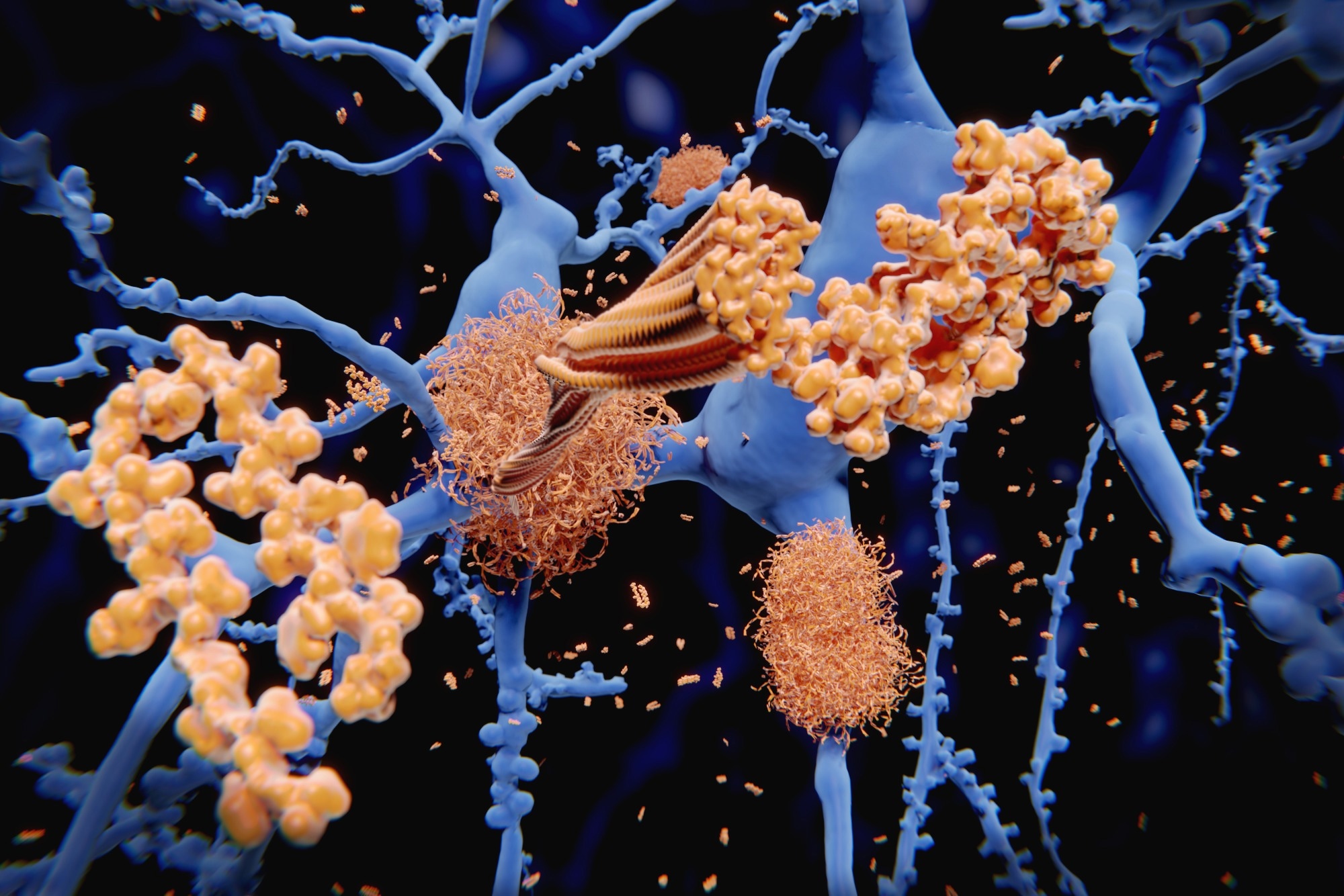AD is a significant medical challenge, as no effective treatment is available. While amyloid plaques are a hallmark of AD pathology, factors driving amyloid-beta (Aβ) deposition, clearance, and plaque compaction are poorly understood. Recent studies have shed light on microglial engulfing and processing of Aβ.
 Study: Regulation of cell distancing in peri-plaque glial nets by Plexin-B1 affects glial activation and amyloid compaction in Alzheimer’s disease. Image Credit: Juan Gaertner / Shutterstock
Study: Regulation of cell distancing in peri-plaque glial nets by Plexin-B1 affects glial activation and amyloid compaction in Alzheimer’s disease. Image Credit: Juan Gaertner / Shutterstock
Microglial phagocytic activity promotes plaque compaction, limiting the healthy neuron exposure to plaque. Furthermore, microglial coverage of plaques serves as a barrier limiting neurite exposure to neurotoxic protofibrillar Aβ hotspots. Amyloid plaques are also surrounded by reactive astrocytes. As such, the microglia and reactive astrocytes closely interact with Aβ and one another, forming peri-plaque glial nets.
Plexin-B1 is an axon guidance receptor; plexins and their cognate ligands mediate cell-cell communication during development, cancer, and adult physiology. Previously, the authors identified plexin-B1 as a hub gene in a sub-network underlying late-onset AD. In addition, other studies have independently implicated plexin-B1 in AD pathophysiology; however, functional in vivo data are lacking.
The study and findings
In the present study, researchers investigated the functional significance of plexin-B1 in AD. They explored a gene expression database and found that plexin-B1 was predominately expressed in astrocytes in the human and mouse central nervous system (CNS). RNAscope in situ hybridization and immunofluorescence were performed on brain sections of a six-month-old amyloidogenic mouse model of AD (APP/PS1 mice).
A high density of Plxnb1 mRNA was observed in peri-plaque glial fibrillary acidic protein (GFAP+) reactive astrocytes. Activated microglia around the plaque had scant Plxnb1 mRNA. Further, plexin-B1 expression was assessed using a Plxnb1 knockout (PB1-KO) allele containing a LacZ cassette before Plxnb1’s promoter and initial exons.
PB1-KO allele was bred into APP/PS1 mice. LacZ/X-Gal staining from six-month-old Plxnb1+/- mice demonstrated distinct X-gal signals near plaques. This confirmed plexin-B1 upregulation in peri-plaque areas. Further, immunohistochemical analysis of human AD specimens showed high plexin-B1 signals around amyloid plaques.
Next, the cytoarchitecture of peri-plaque glial nets was compared between APP/PS1 mice with and without Plxnb1. Plexin-B1 deletion led to a much smaller footprint of peri-plaque glial nets. Besides, the cell-cell distancing of plaque-related astrocytes was reduced in mice without Plxnb1. Plexin-B1 ablation resulted in smaller, more compact glial nets with increased plaque coverage.
Moreover, plexin-B1 deletion reduced the number of peri-plaque microglia and the spacing of plaque-related microglia. Next, bulk RNA sequencing of the prefrontal cortex of mice with and without plexin-B1 was performed. This revealed over 2,700 genes with differential expression (DEGs). Pathway analyses indicated that upregulated DEGs in mice without plexin-B1 were enriched for gene ontology terms associated with synaptic function and nervous system development.
Conversely, downregulated genes were related to tissue inflammation and damage, mechanical stimulus detection, and protein deacetylase activity. Overall, plexin-B1 ablation had a protective effect, augmented synaptic/neuronal function, and attenuated neuroinflammation and cell death. Next, single-cell RNA sequencing was performed.
Among the 10 distinct clusters defined by the expression of marker genes, microglia formed the largest cluster, followed by endothelial cells and astrocytes. Astrocytes formed nine transcriptionally distinct sub-clusters (sc-0 – sc-8). Sc-8 astrocytes were enriched for gene signatures of disease-associated astrocytes (DAAs) observed in an AD mouse model.
The microglia cluster formed 11 sub-clusters, with the sc-9 sub-cluster being closely associated with the disease-associated microglia (DAM) in the AD mouse model. Further, plexin-B1 deletion augmented signaling communication from astrocytes to microglia, featuring chemoattraction, lipid metabolism, and neuroprotection. Besides, microglia-to-astrocyte communication was affected by plexin-B1 deletion, although it was again mainly enhanced.
Histological examination of amyloid plaques showed a significant decrease in plaque burden in PB1-KO mice with much smaller plaque sizes. Finally, Barnes Maze behavioral assays were performed to compare the memory performance of APP/PS1 mice with and without PB1-KO. They observed a significant improvement in working memory performance in PB1-KO mice in acquisition training trials. By contrast, memory recall was similar in probe trials between mice with and without PB1-KO.
Conclusions
The study illustrated the upregulation of plexin-B1 in astrocytes in peri-plaque glial nets and its involvement in glial cell mobilization and cell-cell distancing around plaques. In the absence of plexin-B1, cell-cell distancing was reduced in peri-plaque nets, and plaque coverage by glial processes was enhanced. Further, plexin-B1 deletion induced transcriptional changes associated with improved activation of DAMs and DAAs and enhanced signaling communication. Collectively, the results suggest plexin-B1 inhibition as an alternative therapeutic strategy in AD.
Journal reference:
- Huang Y, Wang M, Ni H, et al. Regulation of cell distancing in peri-plaque glial nets by Plexin-B1 affects glial activation and amyloid compaction in Alzheimer’s disease. Nat Neurosci, 2024, DOI: 10.1038/s41593-024-01664-w, https://www.nature.com/articles/s41593-024-01664-w